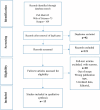Capitonnage Versus Non-Capitonnage in Pediatric Pulmonary Hydatid Disease: A Systematic Review and Meta-Analysis
- PMID: 39633836
- PMCID: PMC11615648
- DOI: 10.1002/hsr2.70235
Capitonnage Versus Non-Capitonnage in Pediatric Pulmonary Hydatid Disease: A Systematic Review and Meta-Analysis
Abstract
Background and aim: Pulmonary hydatid disease, caused by Echinococcus granulosus, presents significant clinical challenges, particularly in pediatric populations. Surgical intervention remains the gold standard for treatment, with various techniques employed, including capitonnage and non-capitonnage methods. This systematic review and meta-analysis evaluates the efficacy and safety of capitonnage compared to non-capitonnage techniques in children.
Methods: This systematic review and meta-analysis followed the PRISMA guidelines to ensure methodological rigor. A comprehensive literature search was conducted across PubMed, Web of Science, and Scopus databases to identify relevant studies. To assess pooled event rates and corresponding 95% confidence intervals for both complications and cure rates, we employed a random-effects model, allowing for variability among study populations. All statistical analyses were conducted using Comprehensive Meta-Analysis software (version 3.7).
Results: Thirteen studies met the established inclusion criteria for analysis. The overall complication rate was 46%, with significantly lower rates in the capitonnage group (24%) compared to the non-capitonnage group (58%). The cure rate was higher in the capitonnage group (83.5%) than in the non-capitonnage group (65.2%). Meta-regression analysis indicated that complication rates were influenced by cyst diameter, study publication date, mean age, and type of surgery.
Conclusion: The findings suggest that capitonnage is associated with better outcomes in terms of lower complication rates and higher cure rates. This evidence supports the use of capitonnage as a preferred surgical technique for managing pulmonary hydatid disease in children. Further research is recommended to explore the long-term outcomes and potential benefits of combining surgical and pharmacological treatments.
Keywords: Echinococcus granulosus; capitonnage; pulmonary hydatid; surgery.
© 2024 The Author(s). Health Science Reports published by Wiley Periodicals LLC.
Conflict of interest statement
The authors declare no conflict of interest. There are no financial or personal relationships that could inappropriately influence or bias the content of the research.
Figures





References
-
- Bennett J. E., Dolin R., and Blaser M. J., Mandell, Douglas, and Bennett's Principles and Practice of Infectious Diseases E‐Book: 2‐Volume Set (Elsevier health sciences, 2019).
-
- Guska S., Cerimagić Z., and Pilav I., “Conservative Surgical Treatment of Pulmonary Hydatid Disease in Children,” Medicinski Arhiv 61, no. 1 (2007): 11–15. - PubMed
-
- Kıreşi D. A., Karabacakoğlu A., Ödev K., and Karaköse S., “Pictorial Review: Uncommon Locations of Hydatid Cysts,” Acta Radiologica 44, no. 6 (2003): 622–636. - PubMed
-
- Karavdic K. and Guska S., “Surgical Treatement of Pulmonary Hydatid Disease in Children‐A Retrospective Study,” Medicinski Arhiv 65, no. 1 (2011): 16–19. - PubMed
Publication types
LinkOut - more resources
Full Text Sources
Miscellaneous

